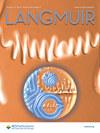Investigation of Erosion and Deposition Due to Flows with Particles
IF 3.7
2区 化学
Q2 CHEMISTRY, MULTIDISCIPLINARY
引用次数: 0
Abstract
In this work, we employed experimental technique to study the issue of particle erosion and deposition in multiphase flows involving both particles of micro/meso- and nanoscale (sand particles and iron oxide particles). Especially, liquids with immersed nanoparticles gained a lot of interest in the recent years due to their enhanced thermal properties. At the same time, this type of fluids is still not widely used in practical and engineering applications, and one of the reasons is a risk of leading to erosion and deposition on, for instance, pipe walls. In our experiments, an aluminum plate was subjected to a flow with particles by immersing it in a beaker with a rotating fluid for 530 h. After this, the plate was investigated using scanning electron microscopy (SEM) and atomic force microscopy (AFM), followed by energy dispersive X-ray (EDX) analysis. According to our observations, the erosion was mainly caused by the largest particles (sand particles), while the nanoparticles did not lead to clear erosion but resulted in significant deposition due to strong adhesion, as well as corrosion, resulting in aluminum oxide formation. This issue was also confirmed through theoretical analysis by comparing the momentum response time and the characteristic time of the flow, as well as computational fluid dynamics (CFD) simulations.

带颗粒的水流造成的侵蚀和沉积调查
在这项工作中,我们采用实验技术研究了微米级和纳米级粒子(沙粒和氧化铁粒子)在多相流中的侵蚀和沉积问题。近年来,浸入纳米颗粒的液体因其更强的热性能而备受关注。与此同时,这类液体在实际和工程应用中仍未得到广泛使用,原因之一是有可能导致侵蚀和沉积在管壁等处。在我们的实验中,我们将一块铝板浸入装有旋转流体的烧杯中 530 小时,使其受到颗粒流的影响。根据我们的观察,侵蚀主要是由最大的颗粒(沙粒)引起的,而纳米颗粒并没有导致明显的侵蚀,但由于附着力强而导致大量沉积,以及腐蚀,形成氧化铝。通过比较流动的动量响应时间和特征时间以及计算流体动力学(CFD)模拟,理论分析也证实了这一问题。
本文章由计算机程序翻译,如有差异,请以英文原文为准。
求助全文
约1分钟内获得全文
求助全文
来源期刊

Langmuir
化学-材料科学:综合
CiteScore
6.50
自引率
10.30%
发文量
1464
审稿时长
2.1 months
期刊介绍:
Langmuir is an interdisciplinary journal publishing articles in the following subject categories:
Colloids: surfactants and self-assembly, dispersions, emulsions, foams
Interfaces: adsorption, reactions, films, forces
Biological Interfaces: biocolloids, biomolecular and biomimetic materials
Materials: nano- and mesostructured materials, polymers, gels, liquid crystals
Electrochemistry: interfacial charge transfer, charge transport, electrocatalysis, electrokinetic phenomena, bioelectrochemistry
Devices and Applications: sensors, fluidics, patterning, catalysis, photonic crystals
However, when high-impact, original work is submitted that does not fit within the above categories, decisions to accept or decline such papers will be based on one criteria: What Would Irving Do?
Langmuir ranks #2 in citations out of 136 journals in the category of Physical Chemistry with 113,157 total citations. The journal received an Impact Factor of 4.384*.
This journal is also indexed in the categories of Materials Science (ranked #1) and Multidisciplinary Chemistry (ranked #5).
 求助内容:
求助内容: 应助结果提醒方式:
应助结果提醒方式:


